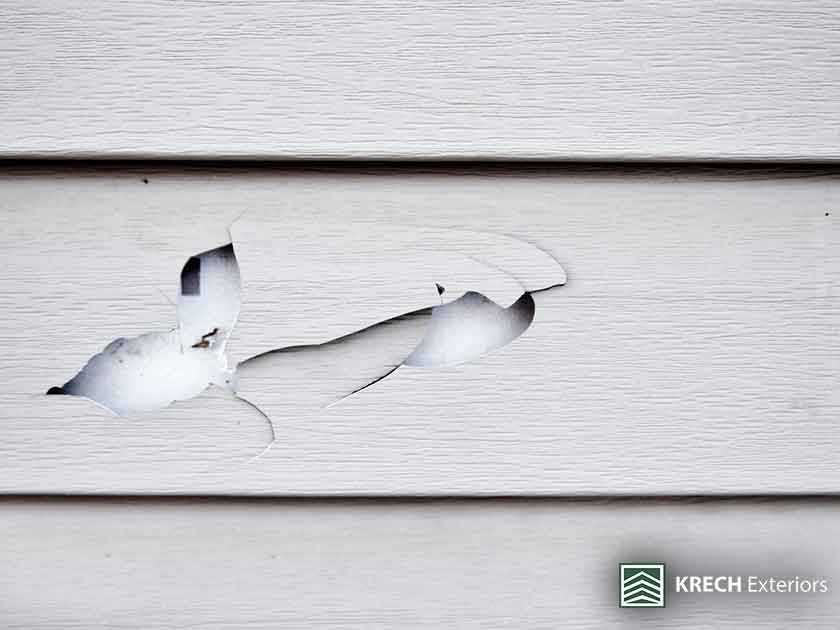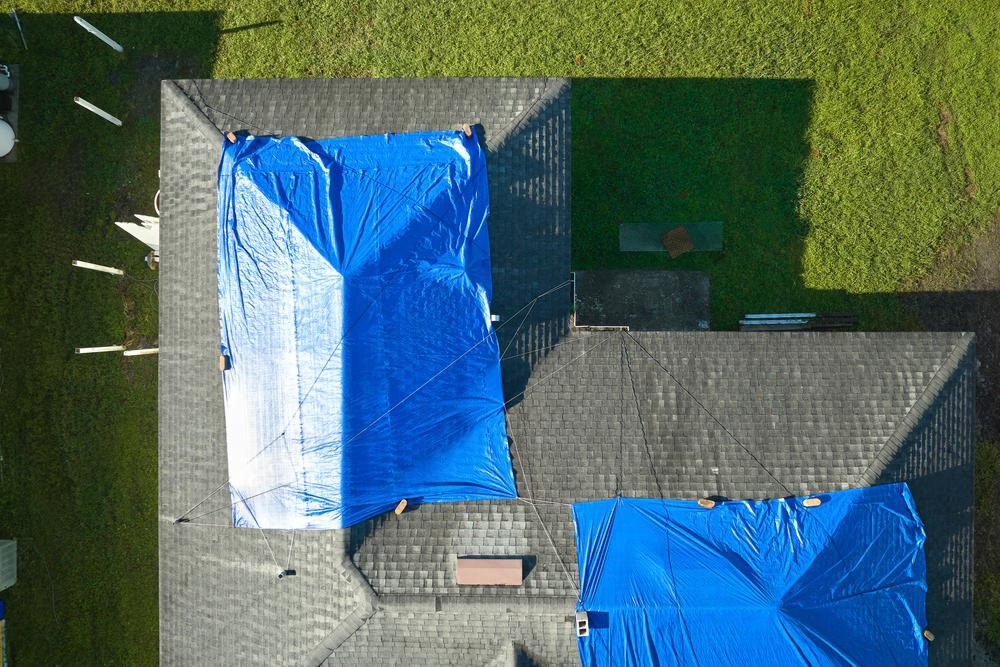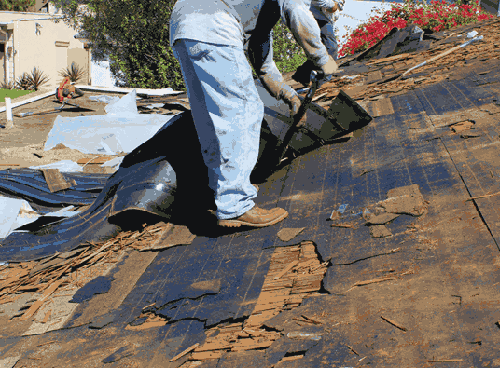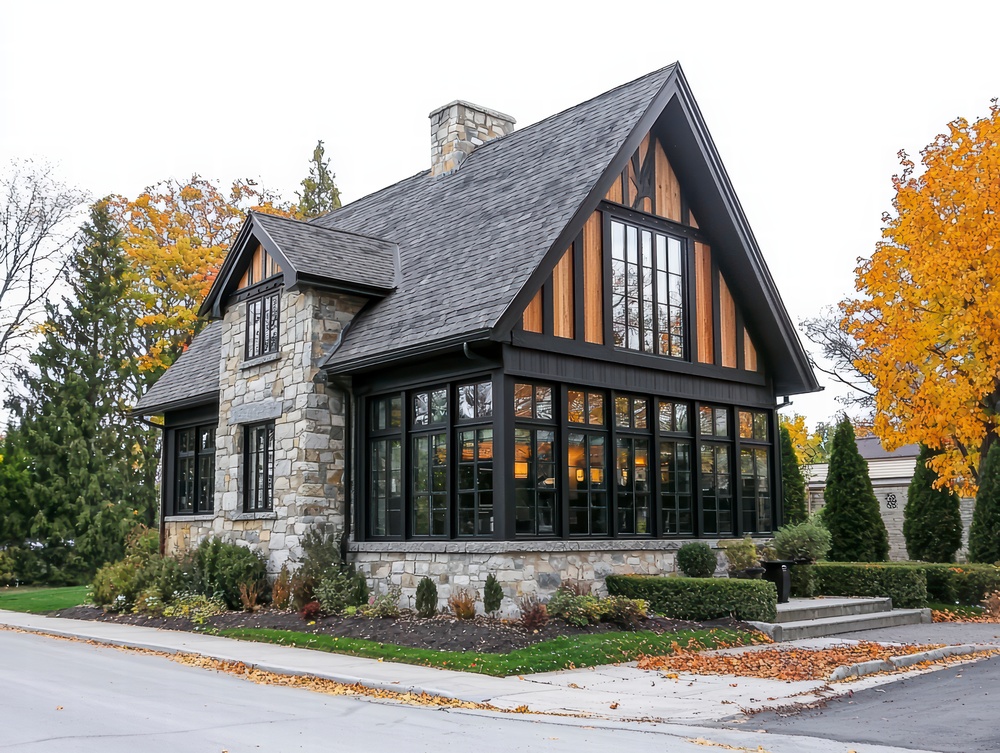Your siding is more than just a design feature—it’s your home’s first line of defense against Minnesota’s harsh climate. Certain siding types, such as wood siding, are considered an attractive option for homeowners because of their visual appeal and their ability to enhance your home’s resale value. From snowstorms in St. Paul to hail in Lakeville, Twin Cities weather can take a serious toll on your home’s exterior. But it’s not just the weather—many factors can gradually weaken your siding, leading to costly repairs or even full replacement.
At Krech Exteriors, we’ve spent over 35 years helping homeowners across the Minneapolis–St. Paul metro area understand, prevent, and repair siding damage. This guide outlines the most common culprits behind siding deterioration—and how you can stay ahead of the damage.
Key Takeaways
- Twin Cities weather, including hail, snow, and extreme temperature swings, is a top cause of siding wear.
- Improper installation and poor-quality materials shorten your siding’s lifespan.
- Mold, moisture, and UV damage often go unnoticed until it’s too late.
- Routine inspections and timely siding repairs can extend the life of your siding.
- James Hardie fiber cement siding offers superior resistance to many common siding threats.
Introduction to Siding Damage
Siding damage is a concern that every Twin Cities homeowner should take seriously, no matter what type of siding material protects your home. From wood siding to vinyl, fiber cement, and aluminum, all siding materials face threats from harsh weather conditions, poor installation, and excess moisture. When siding damage goes unnoticed or untreated, it can quickly escalate—leading to mold growth, structural damage, and costly repairs that impact both your wallet and your home’s safety. Common signs of siding problems include visible cracks, warping, and discoloration, but some issues can be hidden beneath the surface. That’s why regular inspections and proactive maintenance are essential. By staying vigilant and addressing minor issues early, you can prevent more serious siding problems and keep your home’s exterior in top shape.
Siding Materials and Vulnerabilities
Every siding material has its own set of strengths and weaknesses, and understanding these vulnerabilities is key to protecting your home. Wood siding, for example, is admired for its classic look but is highly susceptible to moisture damage, rot, and attacks from insects like carpenter ants. Vinyl siding is a popular, low-maintenance choice, but it can experience cracking, significant fading, and warping—especially after years of exposure to Minnesota’s temperature swings. Fiber cement siding, such as James Hardie, offers impressive durability but can still suffer from cracking or water damage if not installed correctly. Aluminum siding is lightweight and resists rot, but it can dent easily and may corrode or fade over time. Engineered wood siding provides a modern alternative to traditional wood, but it can be prone to delamination, warping, and rot if exposed to excessive moisture. Knowing the unique vulnerabilities of your siding material helps you spot potential issues early and take the right steps to prevent further damage.
Signs of Siding Damage
Spotting siding damage early can save you from major headaches down the road. Keep an eye out for visible damage like cracks, holes, or dents in your siding—these are clear indications that repairs may be needed. Moisture damage often reveals itself through warping, rotting, or mold growth on the siding’s surface. Loose siding panels, peeling paint, and water stains on your interior walls are also warning signs that moisture may be seeping in. If you notice significant fading, excessive moisture around your home’s foundation, or a sudden spike in your utility bills, these could all point to underlying siding problems. Regularly inspect your siding for these issues to catch minor cracks or moisture infiltration before they turn into significant problems.
Interior Signs of Siding Damage
Siding damage doesn’t just affect your home’s exterior—it can also show up inside. Watch for water stains, mold growth, or peeling paint on your interior walls, as these can signal that moisture is making its way past your siding. Loose wallpaper, musty odors, and discoloration on ceilings or walls are other common signs that your siding may be compromised. You might also notice cold spots, drafts, or rising energy bills, which can indicate that your siding is no longer providing proper insulation. Addressing these interior signs of siding damage quickly is crucial to prevent further damage to both your home’s interior and exterior.
1. Moisture Infiltration
Moisture is the silent destroyer of many exterior surfaces. Moisture infiltration can lead to mold mildew growth, which poses potential health risks and can cause damage to your home’s interior. In Minnesota’s freeze-thaw climate, trapped moisture can seep behind siding and lead to rot, warping, and mold. Wood siding is particularly vulnerable, but even vinyl and fiber cement can suffer if moisture barriers are compromised.
Tip: Look for bubbling paint, soft patches, or a musty smell—these could signal water damage beneath your siding.
2. Hail and Storm Damage
In Eagan and other parts of the Twin Cities, hailstorms are a regular threat. Large hailstones can crack, chip, or puncture siding panels—especially vinyl or aluminum varieties. For minor dents in aluminum siding, a common repair method involves heating the area and then applying cold water to help shrink the metal and restore its shape. Over time, repeated impacts weaken structural integrity and make your home more vulnerable to moisture and pests.
Preventive Measure: After any significant storm, schedule a professional inspection. Krech Exteriors provides storm damage assessments and helps homeowners navigate insurance claims.
Learn more about our storm damage repair process
3. Sun Exposure and UV Fading
Siding faces constant exposure to ultraviolet rays, which can cause fading and material breakdown. Prolonged sun exposure can degrade siding materials, reducing the home’s energy efficiency and potentially leading to high utility bills due to increased heating and cooling demands. While this is more common on south-facing walls, all sides of a home will eventually show signs of sun wear, especially on older or lower-grade siding.
Why It Matters: Faded siding doesn’t just hurt curb appeal—it may also signal underlying brittleness that leads to cracking or warping.
4. Poor Installation
No matter how high-quality your siding is, poor installation will undermine its performance. Proper installation, including correct flashing and sealing, is essential to prevent moisture damage and ensure siding longevity. Improper spacing, missing flashings, or loose panels can create weak points where moisture or pests can enter.
At Krech Exteriors, we follow strict manufacturer guidelines—especially with James Hardie fiber cement siding—to ensure every project meets local code and manufacturer warranty standards.
Explore our professional siding installation services!
5. Insect and Pest Infestation
Wood siding is particularly attractive to carpenter ants, termites, and even woodpeckers, as well as other pests such as bees and wasps that can also cause damage to siding. Once inside, pests can burrow deep into boards, weakening their structure and inviting more damage.
How to Spot It: Look for small holes, sawdust near the base of walls, or strange tapping noises (yes, that’s probably a woodpecker).
6. Freeze-Thaw Cycle Cracks
In places like Woodbury and Bloomington, winter can be especially brutal on siding. Water seeps into microscopic cracks during warmer days, then freezes and expands at night. This cycle widens existing cracks and can split siding boards over time. Fiber cement siding can experience cracks as well, especially after prolonged exposure to these harsh freeze-thaw conditions.
Solution: Fiber cement siding like James Hardie resists these freeze-thaw cycles far better than traditional wood or vinyl options.
7. Improper Maintenance
Even the best siding needs basic upkeep. Addressing minor damage, such as small cracks, with prompt repairs and using a soft brush for gentle cleaning can help maintain siding integrity. Letting grime, algae, or mildew build up can hide developing issues. Neglecting caulking or failing to replace cracked boards invites further deterioration.
Seasonal Tip: Schedule a spring and fall siding inspection to identify minor issues before they grow into major expenses.
8. Low-Quality Materials
Not all siding is created equal. Lower-end vinyl may crack in cold weather, while cheap aluminum can dent easily. These materials might save money upfront, but often lead to faster deterioration and more frequent repairs.
At Krech Exteriors, we recommend premium brands like James Hardie and CertainTeed because they’re engineered for long-term performance in Minnesota’s demanding climate. Upgrading your house siding with new siding can significantly improve your home’s durability and curb appeal, while timely siding replacement is essential for maintaining your home’s value.
9. Mold and Mildew
Mold and mildew are more than just unsightly—they’re a clear indication of siding damage and can pose significant health and structural risks. When excess moisture becomes trapped behind damaged siding, it creates a breeding ground for mold and mildew, which can spread quickly and compromise your home’s structural integrity. Regular maintenance, such as professional cleaning and prompt repairs, can help prevent mold and mildew growth. However, it’s just as important to address the root causes, such as damaged siding, improper installation, or the use of low-quality materials. Ensuring your siding is installed correctly and made from quality materials will help keep moisture out and protect your home from further damage. By staying proactive, you can maintain a safe, healthy environment and avoid costly repairs down the line.
Ready to Protect Your Home’s Exterior?
Ready to Protect Your Home’s Exterior? Maintaining your home’s exterior is crucial to prevent siding issues and ensure lasting protection and curb appeal.
If you’ve noticed signs of siding wear—or want expert guidance before problems arise—Krech Exteriors is here to help. We bring over 35 years of experience, a commitment to craftsmanship, and the industry’s best warranties to every home we serve.
FAQ: What Weakens Your Siding?
How often should siding be inspected?
We recommend inspecting your siding at least twice a year—ideally in spring and fall—and after major storms. It’s important to have your siding inspected by a professional to catch problems early.
Can I repair damaged siding, or do I need full replacement?
It depends on the extent of the damage. Minor cracks or isolated rot can often be addressed with siding repair, and prompt repairs can prevent further issues and significant damage. Widespread issues may require replacement.
Does fading siding mean it’s time to replace it?
Fading is often cosmetic, but it may also signal age-related brittleness. A professional inspection can help determine the next steps.
What’s the most durable siding for Minnesota homes?
James Hardie fiber cement siding offers superior resistance to moisture, fire, pests, and extreme temperatures—making it ideal for Minnesota’s climate.
Can hail damage be invisible?
Yes, not all hail damage is obvious. Hidden cracks can allow water infiltration, so it’s wise to get a professional inspection after hail events.






